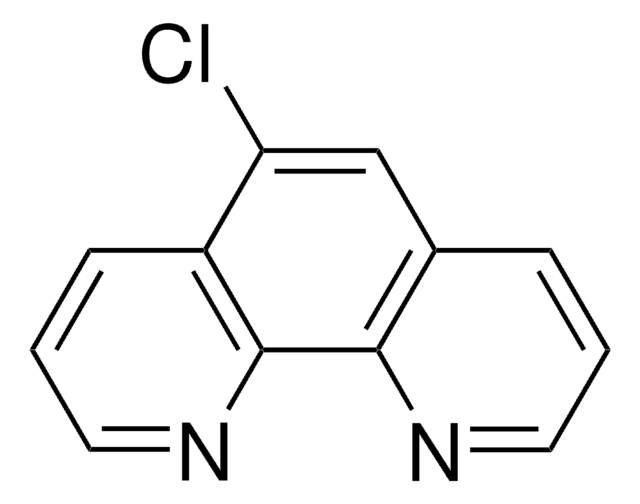8.41491
1,10-Phenanthroline
(anhydrous) for synthesis
Synonyme(s) :
1,10-Phenanthroline
About This Item
Produits recommandés
Niveau de qualité
Forme
powder
Puissance
132 mg/kg LD50, oral (Rat)
Pf
117-119 °C
Solubilité
2.69 g/L
Température de stockage
2-30°C
InChI
1S/C12H8N2/c1-3-9-5-6-10-4-2-8-14-12(10)11(9)13-7-1/h1-8H
Clé InChI
DGEZNRSVGBDHLK-UHFFFAOYSA-N
Application
- Optoelectronic applications: 1,10-Phenanthroline was utilized in the synthesis of europium (III) ß-diketonate complexes, demonstrating significant potential in red-emissive display technologies, furthering its use in optoelectronic devices (Redhu et al., 2024).
- Photovoltaic device efficiency: Research involving organic electron transport layers (ETLs) highlighted the use of 1,10-Phenanthroline in enhancing the performance of carbon electrode-based perovskite solar cells, contributing to advancements in solar energy technology (Ijaz et al., 2024).
- Green chemistry catalysts: 1,10-Phenanthroline served as a catalyst in a manganese(II)-based system for the aqueous synthesis of organic heterocycles, emphasizing its role in promoting environmentally friendly chemical processes (Mondal et al., 2024).
- Synthesis and characterization of ligands: The synthesis and spectroscopic analysis of water-soluble ligands based on the 1,10-Phenanthroline core were detailed, expanding its applications in the development of new molecular ligands for coordination chemistry (Nycz et al., 2024).
Remarque sur l'analyse
Melting range (lower value): ≥ 115 °C
Melting range (upper value): ≤ 119 °C
Identity (IR): passes test
Mention d'avertissement
Danger
Mentions de danger
Conseils de prudence
Classification des risques
Acute Tox. 3 Oral - Aquatic Acute 1 - Aquatic Chronic 1
Code de la classe de stockage
6.1C - Combustible, acute toxic Cat.3 / toxic compounds or compounds which causing chronic effects
Classe de danger pour l'eau (WGK)
WGK 3
Point d'éclair (°F)
Not applicable
Point d'éclair (°C)
Not applicable
Certificats d'analyse (COA)
Recherchez un Certificats d'analyse (COA) en saisissant le numéro de lot du produit. Les numéros de lot figurent sur l'étiquette du produit après les mots "Lot" ou "Batch".
Déjà en possession de ce produit ?
Retrouvez la documentation relative aux produits que vous avez récemment achetés dans la Bibliothèque de documents.
Les clients ont également consulté
Notre équipe de scientifiques dispose d'une expérience dans tous les secteurs de la recherche, notamment en sciences de la vie, science des matériaux, synthèse chimique, chromatographie, analyse et dans de nombreux autres domaines..
Contacter notre Service technique






![1,10-Phenanthroline chloride monohydrate GR for analysis and redox indicator [reagent for iron(II)] Reag. Ph Eur](/deepweb/assets/sigmaaldrich/product/images/350/751/c4f466f3-0750-4cb4-af8f-5942eba5d12f/640/c4f466f3-0750-4cb4-af8f-5942eba5d12f.jpg)






